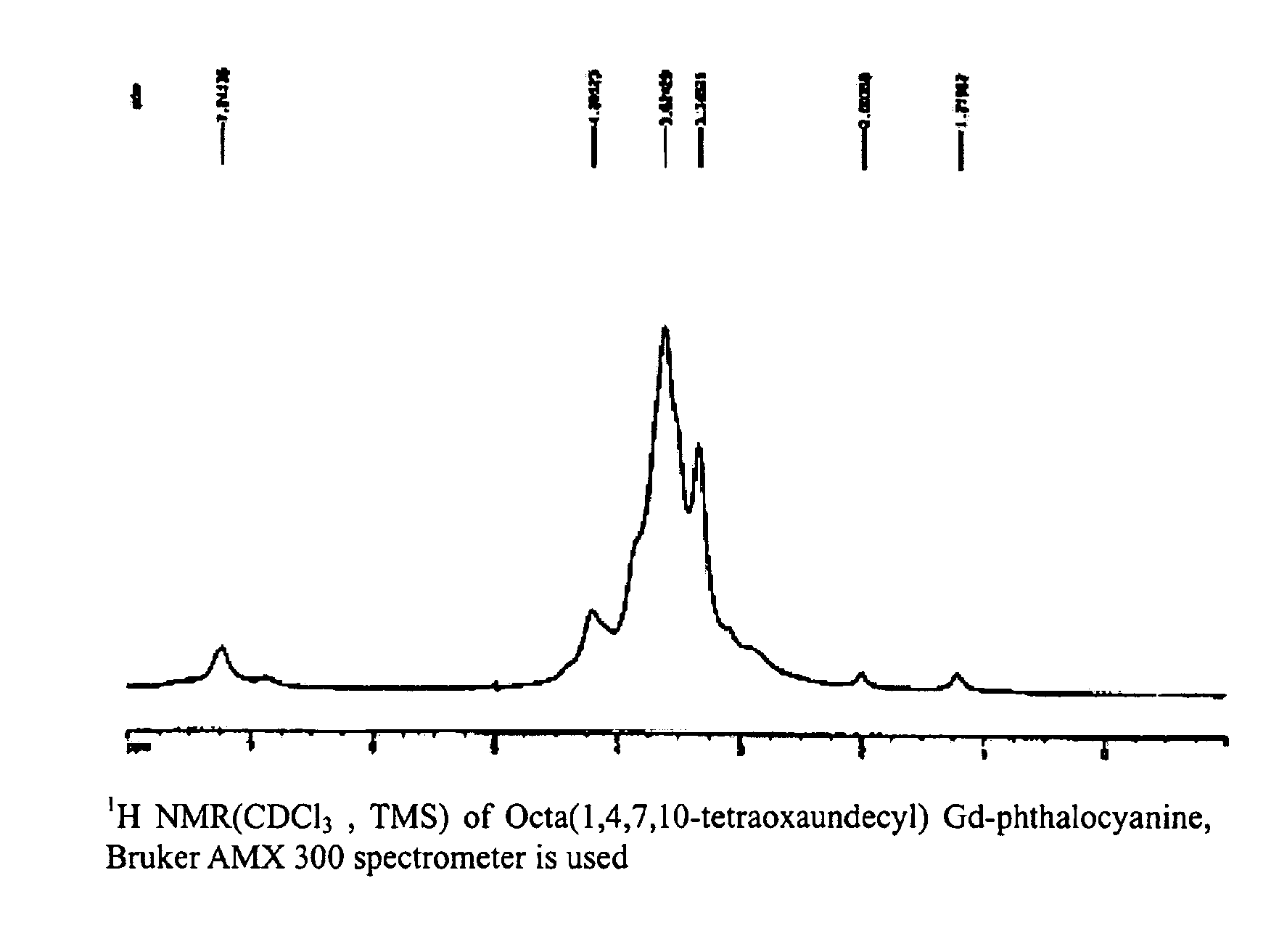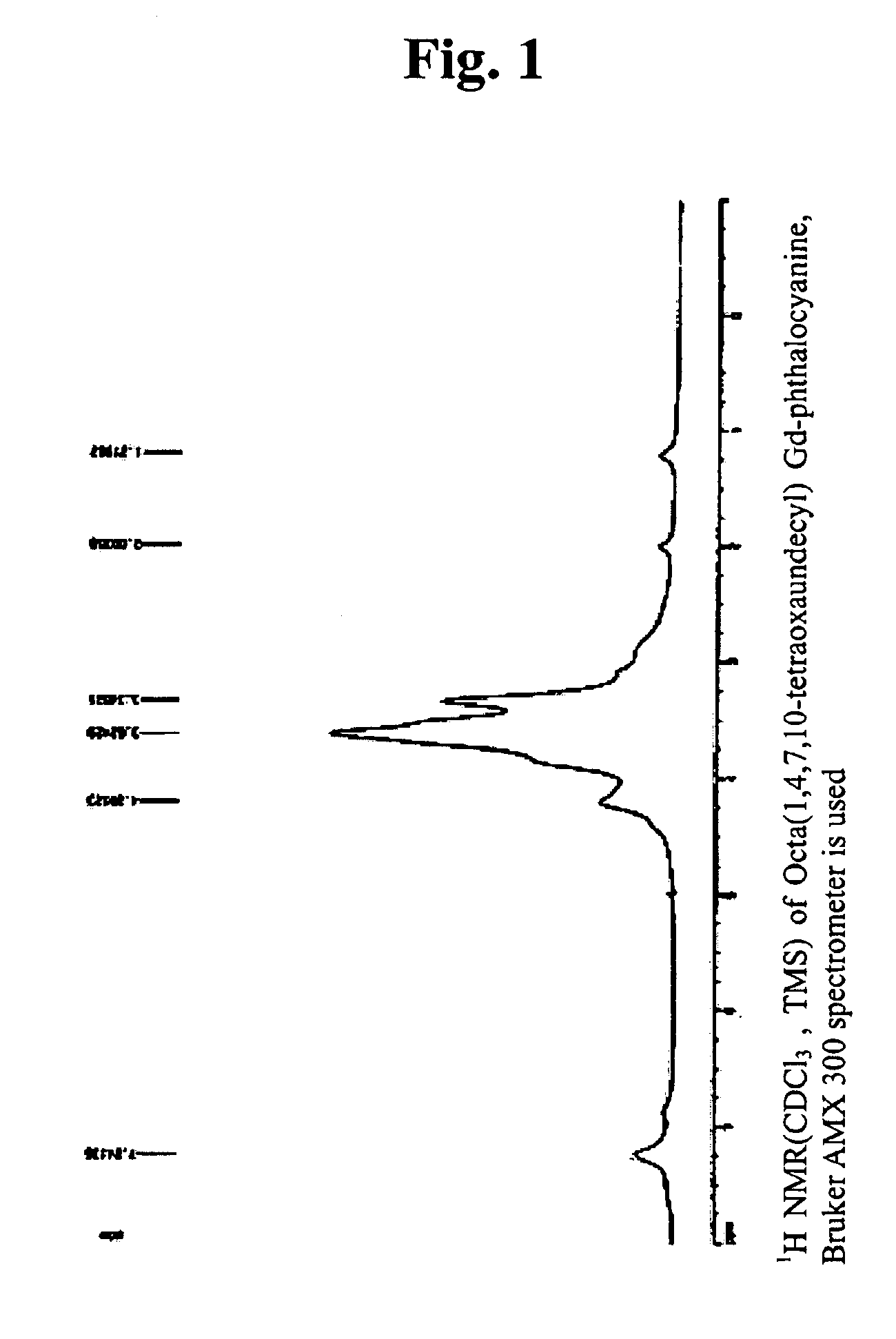Paramagnetic metal-phthalocyanine complex compounds and contrast agent using the same
- Summary
- Abstract
- Description
- Claims
- Application Information
AI Technical Summary
Benefits of technology
Problems solved by technology
Method used
Image
Examples
example 1
Synthesis of octa(1,4,7,10-tetraoxaundecyl)Gd-phthalocyanine
[0049]0.972 g (2.15 mmol) of 1,2-di(1,4,7,10-tetraoxaundecyl)-4,5-dicyanobenzene was dissolved in 10 ml of DMF, and 0.779 g (2.15 mmol) of oxidized gadolinium (III) was added thereto. Then, the reaction was carried out while stirring it for 12 hours at 150° C. After the reaction, the solution was filtered, and the final product was obtained by evaporating the solvent. The product obtained as such was purified with column chromatography, and 0.74 g of octa(1,4,7,10-tetraoxaundecyl)Gd-phthalocyanine was obtained thereby (yield of 69.7%). At that time, a mixed solvent of methanol and CH2CH2 at 1:5 was used for elution solvent.
[0050]The 1H NMR-spectrum and UV-spectrum of the substances obtained as such are shown respectively in FIGS. 1 and 2.
example 2
Synthesis of octa(14,7,10-tetraoxaundecyl)Mn-phthalocyanine
[0051]1.15 g (2.55 mmol) of 1,2-di(1,4,7,10-tetraoxaundecyl)-4,5-dicyanobenzene was dissolved in 10 ml of DMF, and 0.44 g (2.55 mmol) of Mn(OAc)2 was added thereto. Then, the reaction was carried out while stirring it for 4 days at 150° C. After the reaction, the solution was filtered, and the final product was obtained by evaporating the solvent. The product obtained as such was purified with column chromatography, and 0.303 g of octa(1,4,7,10-tetraoxaundecyl)Mn-phtalocyanine was obtained thereby (yield of 25.5%). At that time, a mixed solvent of methanol and CH2CH2 at 1:5 was used for elution solvent.
[0052]The 1H NMR-spectrum and UV-spectrum of the substances obtained as such are shown respectively in FIGS. 3 and 4.
experiment 1
T1 & T2 Measurements of Contrast Agents
[0053]The appropriate amounts of Gd-DTPA (a commercial contrast agent, Magnevist manufactured by Schering, Inc.), octa(1,4,7,10-tetraoxaundecyl)Gd-phthalocyanine (hereinafter referred to as GdPC-Fuxl-6) and octa(1,4,7,10-tetraoxaundecyl)Mn-phthalocyanine (hereinafter referred to as MnPC-Fuxl-18) were respectively dissolved in 0.08% physiological saline solution to produce respective samples at 0.005M concentration. To these samples, 10% of heavy water was added to obtain a lock signal. As for the blank, 0.08% physiological saline solution was prepared.
[0054]With respect to these samples and the blank, the respective relaxation times of protons were measured (values of T1 and T2 (unit: second)) at 80 MHz NMR (Bruker, AC80) and 300 MHz NMR (Bruker, DRX300) respectively. The respective RD values were set sufficiently high in order to eliminate their affects to the test results. The value of d2 of approximately 1˜2 msec was used. The respective val...
PUM
| Property | Measurement | Unit |
|---|---|---|
| Fraction | aaaaa | aaaaa |
| Time | aaaaa | aaaaa |
| Time | aaaaa | aaaaa |
Abstract
Description
Claims
Application Information
 Login to View More
Login to View More - R&D
- Intellectual Property
- Life Sciences
- Materials
- Tech Scout
- Unparalleled Data Quality
- Higher Quality Content
- 60% Fewer Hallucinations
Browse by: Latest US Patents, China's latest patents, Technical Efficacy Thesaurus, Application Domain, Technology Topic, Popular Technical Reports.
© 2025 PatSnap. All rights reserved.Legal|Privacy policy|Modern Slavery Act Transparency Statement|Sitemap|About US| Contact US: help@patsnap.com



